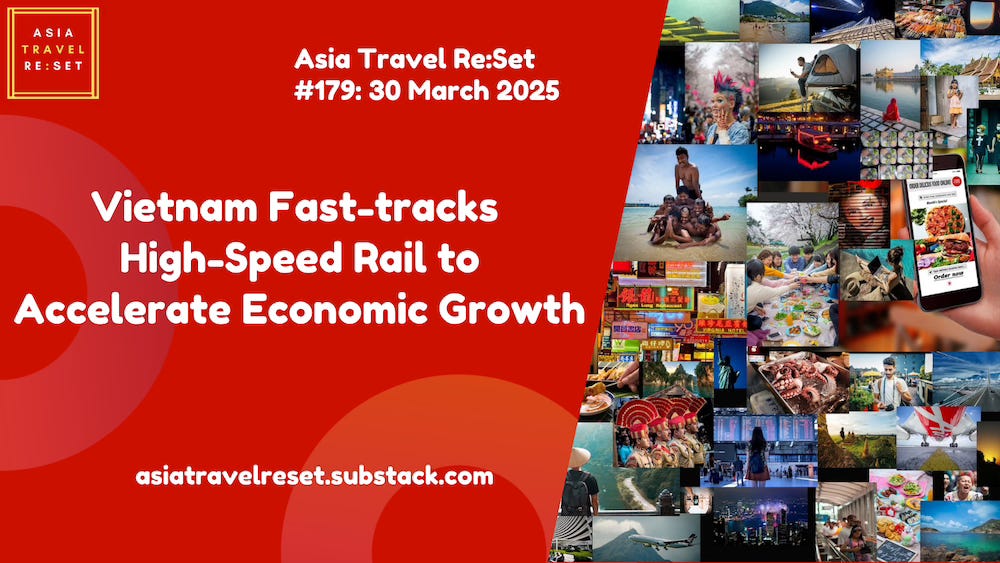Issue #179: Vietnam Fast-tracks High-Speed Rail to Accelerate Economic Growth
Can South East Asia's most ambitious bullet train system power Vietnam's growth?
Welcome to Issue 179 of Asia Travel Re:Set.
So, firstly, all thoughts are with the people of Myanmar after Friday’s earthquake. The full, devastating impacts are still unclear.
So, I said last week that there would be no newsletter this week.
But, March was an intriguing month, which we reviewed on The South East Asia Travel Show. Meanwhile, there’s plenty of speculation about Vietnam’s strategy should it be targeted (next week) by US tariffs.
So, let’s follow that train of thought.
Thanks for checking in…
If you’ll be at the 2025 Short Stay Summit in London on Wednesday, see you there. Our panel, Small world: Big market. Focus on China, has a prime slot, 11.10am. Here’s the blurb…
“The increasing number of Chinese travellers choosing short-stay accommodations over traditional hotels presents a wealth of opportunities for the UK’s short-stay market. With social media influence driving much of Chinese travel planning, providing photogenic, unique properties and curated, shareable experiences are key to showcasing what the UK has to offer.
Join our expert panel as they explore how to calibrate communications, culture and marketing to this largely untapped market.”
In late November, Vietnam set a 10-year schedule to develop South East Asia’s most ambitious bullet train system. What might this mean for Vietnam, and ASEAN?
Below are 5 mini takeaways from my new article, Viet Nam Fast-Tracks High-Speed Rail, for the Asia Media Centre. However, there are 3 caveats to note:
It forms part of a series of long-term national infrastructure projects, and is at least a decade from launching.
Much has changed in global relations since the project was announced 4 months ago. And Liberation Day on Wednesday promises further trade turmoil.
Vietnam is bracing for US tariffs. It has the 4th-largest trade surplus with the US, and was called a “currency manipulator” by the first Trump administration.
So, will Vietnam be able to build the high-speed railway to add scale and resilience to its economy? Or will altered external circumstances force a fiscal rethink?
1) A national network
The 1,541km North-South high-speed railway is ostensibly South East Asia’s first national bullet train system. Trains will speed at up to 350kph from Hanoi to Ho Chi Minh City in around six hours, incorporating stops at coastal cities and destinations, like Hue, Danang and Nha Trang.
2) Bigger economic picture
This is about much more than overland travel, although Vietnam has one of Asia’s fastest growing visitor economies. Mirroring a model pursued by China at the turn of the century, a national transport infrastructure build-out intends to catalyse sustained growth. Enhanced connectivity would help upgrade supply chains, bolster value-added manufacturing, attract investment and drive consumer and travel spend.
3) Complex challenges
‘Can it be achieved?’ is a lingering question. High-speed railways are complex and not easily accomplished. They frequently exceed budgets and schedules. Since Japan launched Asia’s first bullet trains in 1964, only 4 countries have followed in its tracks: South Korea, China, Taiwan and, on a limited scale, Indonesia.
4) Sending a strategic message
The proposed combination of a national high-speed railway and a cross-border express train line with China would send a powerful message to Vietnam’s ASEAN neighbours about its economic plans. The strategic goal is to accelerate, as quickly as possible, from being the region’s 5th- to 2nd-largest economy, behind Indonesia.
5) Selecting a partner
Vietnam has no high-speed rail experience, but has stressed - perhaps as a negotiating stance - that an external rail partner must facilitate technology and skills transfer. It wants to strike a Made in Vietnam deal for the trains and build local supply chains. So, will rail tech companies from China, Japan, South Korea or - a longer shot - France or Spain be willing to trade such competitive advantage for other benefits?
Click HERE to read Viet Nam Fast-Tracks High-Speed Rail
South East Asia's travel and tourism landscape in 2025 will be different to 2024, which contrasted to 2023, which bore little comparison to 2022. None of these years closely resembles 2019, to which they are often compared.
The first 3 months of 2025 showed that regional travel supply and demand are realigning (again). The world is cast in trade confusion. Regional consumer sentiment is softening. Some of those bullish full-year tourism targets may need revising.
On The South East Asia Travel Show, we review March’s Top 8 Talking Points in 8 ASEAN nations and 3 regional markets.
Here are 3 segments to listen out for:
↔️ Competition to attract visitors from vital source markets - China, India and Russia - by Japan, South Korea, UAE, Saudi Arabia, Qatar, Türkiye, and others, will intensity. This could have an erosive impact on ASEAN visitor arrivals if tourism boards don't have integrated defensive and offensive strategies in place.
↔️ Consumer sentiment in ASEAN markets is weakening amid living cost rises, tax increases and economic uncertainty. Indonesia, South East Asia's largest economy, is undergoing austerity, a currency crash and a contracting middle class. GDP growth for 2025 has been revised downward. The rest of the region is watching closely.
↔️ Tourism boards will need to be forensic in their forward planning. We explain the financial methodology behind Singapore's concert tourism strategy over the past 2 years. It is brilliant!
How will these factors impact travel and tourism in South East Asia through what will likely be a turbulent year worldwide…?
Click the live link below to listen to Russian Tourists, Chinese Planes & Singapore’s Forensic Concert Tourism Planing: March 2025 in Review
Or search for The South East Asia Travel Show on any podcast app.
And, that’s a wrap for this issue.
Asia Travel Re:Set will be back next Sunday.
Happy travels,
Gary







